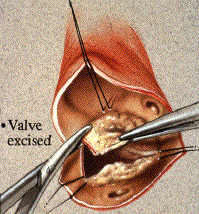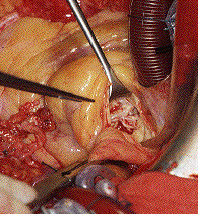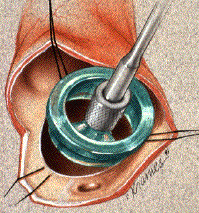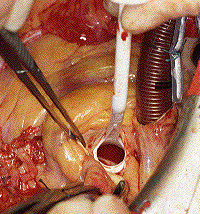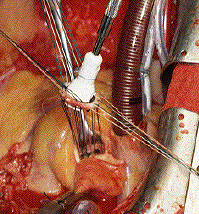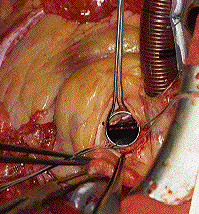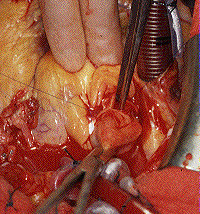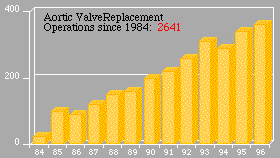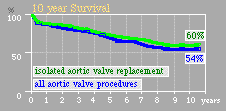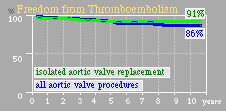aortic valve surgery - historical note:
|
|
step 1: After induction of circulatory support by extracorporeal circulation, cooling of the patient and the heart, the aorta is x-clamped and the aortic valve exposed after the aorta was opened. The aortic valve is examined and excised for subsequent aortic valve replacement. |
|
|
|
step 2: Sizing of the aortic anulus is done by a valve sizer - to select the size of the aortic valve prosthesis. |
|
|
|
step 3: Valve sutures are placed into the aortic valve anulus and into the heart valve prosthesis - to tie the valve prosthesis secure into the valve anulus. |
|
|
|
step 4: picture on the left (<-): The artificial heart valve is in place. picture on the right (->): The aorta is closed by a running suture, the heart de-aired and the operation finished. |
|
|
|
Annual aortic valve operations since 1984 (yellow
bars). Currently, about 360 aortic valve operations are performed
in our hospital annually. Included in this data are also all
re-operations (patients who have undergone previous surgery). The overall perioperative mortality for all 2.641 aortic valve operations since 1984 in our clinic is 1.9% |
|
|
|
| 10 year actuarial survival after aortic valve replacement. Isolated aortic valve replacement operation (green): 60.2%. All aortic valve operations (incl. other procedures like coronary bypass etc) (blue): 54.7% | 10 year freedom from thromboembolism. Isolated aortic valve replacement operation (green): 91.1%. All aortic valve operations (incl. other procedures like coronary bypass etc) (blue): 86.5% |
|
|
|
| 10 year freedom from structural failure. Isolated aortic valve replacement operation (green): 98.0%. All aortic valve operations (incl. other procedures like coronary bypass etc) (blue): 97.7% | 10 year freedom from reoperation. Isolated aortic valve replacement operation (green): 97.7%. All aortic valve operations (incl. other procedures like coronary bypass etc) (blue): 97.4% |
